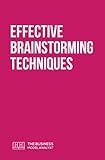Ever felt stuck in a rut, desperately seeking that spark of inspiration? Like a chef searching for the perfect ingredient, we all crave those moments of brilliant insight. The good news is, generating innovative ideas isn’t about magic; it’s about mastering the art of brainstorming. This article will dive deep into detailed techniques for effective brainstorming and idea generation, equipping you with the tools to unlock your creative potential and conquer any mental block.
Understanding the Power of Brainstorming
Brainstorming isn’t just about throwing ideas at a wall and seeing what sticks. It’s a structured process designed to foster creativity and generate a wealth of potential solutions. Think of it as a mental workout, strengthening your innovative muscles and expanding your thinking horizons. Effective brainstorming sessions encourage free-flowing thought, embrace diverse perspectives, and prioritize quantity over quality in the initial stages.
Key Principles of Effective Brainstorming
- Focus on Quantity: The more ideas, the better. Don’t censor yourself or dismiss anything at this stage.
- Embrace Wild Ideas: Encourage out-of-the-box thinking. Sometimes the most seemingly absurd ideas can lead to breakthroughs.
- Defer Judgment: Create a safe space where everyone feels comfortable sharing without fear of criticism.
- Build on Each Other’s Ideas: Encourage collaboration and the development of existing ideas. One person’s thought can spark a chain reaction of innovation.
Detailed Brainstorming Techniques
Now, let’s explore some powerful techniques that can elevate your brainstorming sessions from mediocre to magnificent.
1. Mind Mapping
This visual technique involves starting with a central theme and branching out with related ideas. It’s a fantastic way to organize your thoughts and explore connections between different concepts. Imagine the central idea as the trunk of a tree, with branches representing different avenues of thought.
2. SCAMPER
This acronym stands for Substitute, Combine, Adapt, Modify/Magnify/Minify, Put to other uses, Eliminate, and Reverse/Rearrange. It’s a checklist that prompts you to think about different ways to improve or transform an existing product, service, or process.
3. Reverse Brainstorming
Instead of brainstorming solutions, try brainstorming problems. Identify all the potential downsides or challenges related to your goal, and then flip the script to find solutions that address those issues. This technique can help you uncover hidden obstacles and develop more robust solutions.
4. The Six Thinking Hats
Developed by Edward de Bono, this method encourages you to look at a problem from six different perspectives: White (facts and information), Red (emotions and intuition), Black (critical judgment), Yellow (optimism and benefits), Green (creativity and new ideas), and Blue (process and control). This structured approach ensures a comprehensive exploration of all angles.
5. Role-Playing
Stepping into someone else’s shoes can offer fresh insights. Imagine you’re your target customer, a competitor, or even a historical figure. How would they approach the problem? This technique can break down assumptions and uncover unexpected solutions.
Overcoming Brainstorming Challenges
Even with the best techniques, brainstorming can sometimes hit a snag. Here are a few common challenges and how to address them:
1. Groupthink
This occurs when the desire for harmony overrides critical thinking, leading to a lack of diverse perspectives. Encourage dissenting opinions and create a safe space for constructive disagreement.
2. Dominating Personalities
If one person monopolizes the conversation, gently steer the focus back to others. Use structured techniques like round-robin brainstorming to ensure everyone gets a chance to contribute.
3. Lack of Focus
Establish clear objectives at the beginning of the session and regularly check in to ensure you’re staying on track. A well-defined goal acts as a compass, guiding your brainstorming efforts.
The Role of Preparation in Effective Brainstorming
Just like a chef prepares their ingredients before cooking, successful brainstorming requires pre-planning. Clearly define the problem or opportunity you want to address. Research relevant information and gather any necessary data. A well-prepared mind is a fertile ground for creative ideas.
 Effective Brainstorming Techniques
Effective Brainstorming Techniques
- Pereira, Daniel (Author)
- English (Publication Language)
- Michalko, Michael (Author)
- English (Publication Language)
- Young, James Webb (Author)
- English (Publication Language)
- Snyder, Philip I. (Author)
- English (Publication Language)
- Cotton, David (Author)
- English (Publication Language)
- Vorspan, Ben (Author)
- English (Publication Language)
- Cory, Timothy R. (Author)
- English (Publication Language)
- Kaptein, Arthur (Author)
- English (Publication Language)
- Phillips, Jennifer Cole (Author)
- English (Publication Language)
Conclusion
Mastering the art of brainstorming is essential for anyone seeking to innovate and generate fresh ideas. By understanding the principles of effective brainstorming and employing the detailed techniques outlined in this article, you can unlock your creative potential and overcome any mental block. Remember, the key is to embrace experimentation, encourage diverse perspectives, and prioritize quantity over quality in the initial stages. So gather your team, sharpen your mental pencils, and embark on a brainstorming adventure! What techniques have you found most effective in your own brainstorming sessions? Share your thoughts and experiences in the comments below. We’d love to hear from you!










